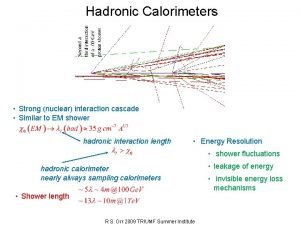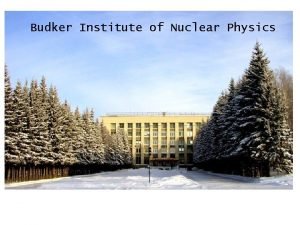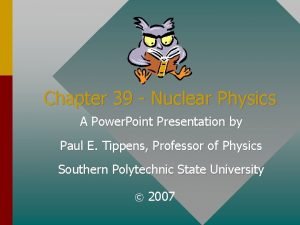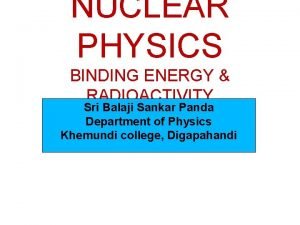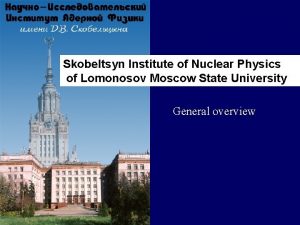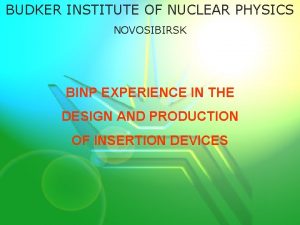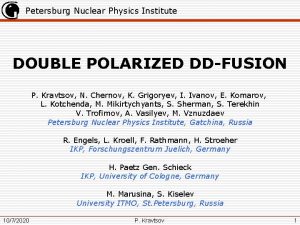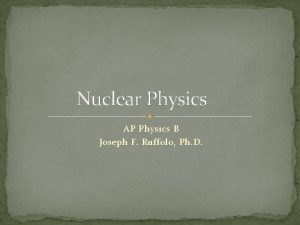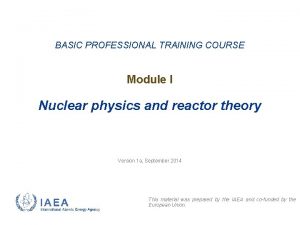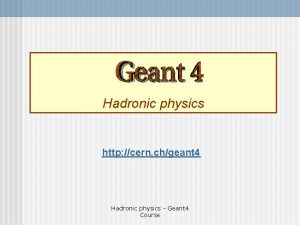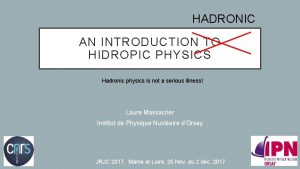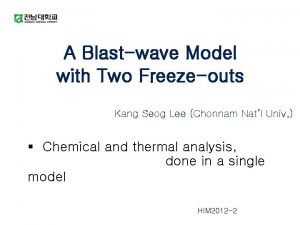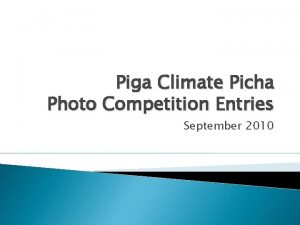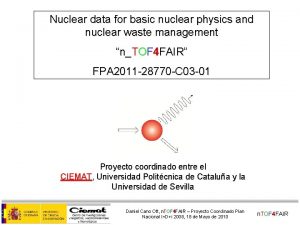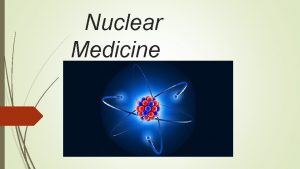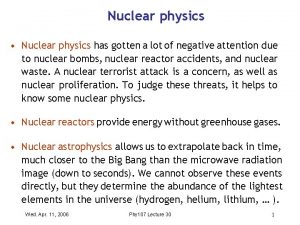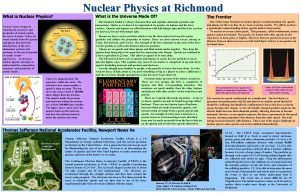Hadronic Freezeouts Roppon Picha UC Davis Nuclear Physics












- Slides: 12

Hadronic Freeze-outs Roppon Picha UC Davis Nuclear Physics Group 20 Aug 2004

• Stages of a nuclear collision deconfined quarks and gluons. (RHIC collisions are believed to provide conditions for QGP, early universe) • chemical freeze-out: end of inelastic collisions. quark flavor composition is fixed. “system is cooked” • kinetic freeze-out: after this, particles no longer interact. “system is served (as spectra)” lat. QCD: QGP -> HG at Tc ~ 170 Me. V Karsch, Nucl. Phys. A 698, 199 c (2002) Karsch, hep-lat/0401031 2

Chemical freeze-out • chemical equilibrium = particle compositions are fixed • based on the grand canonical (GC) ensemble: large system, number of particles can fluctuate until freeze-out, conservation laws make use of chemical potential. • as opposed to canonical ensemble, where system is small (low energy HIC, e+e-, peripheral HIC), N is fixed, and conservation laws must be obeyed within each event. GC Braun-Munzinger et al, nucl-th/0311005 Braun-Munzinger et al, nucl-th/0304013 Cleymans et al, J. Phys. G 25, 281 (1999) 3

Statistical model • to describe the particle yield, the model uses the chemical freeze-out temperature (Tch), the chemical potentials (μ), and the strangeness saturation factor (γs) • The number density of particle i can be described by Rafelski, Phys. Lett. B 262, 333 (1991) Sollfrank, J. Phys. G 23, 1903 (1997) Sollfrank et al, Phys. Rev. C 59, 1637 (1999 4

Kinetic freeze-out • density & temperature of the particle system are low enough that particles no longer scatter mean free path (λ) ≈ system size (R) scattering rate (<β>/λ) ≈ expansion rate (∂µuµ) time between collisions ≈ Hubble time (1/H) • • momentum distribution “frozen” spectra shape gives: • • temperature at freeze-out (inverse slope in high-m. T region) collective expansion velocity (flattening in low-m. T region) Schnedermann and Heinz, PRC 50, 1675 (1994) Kolb, nucl-th/0304036 5

Blast-wave model • source is boosted by scattering of produced particles • any partonic flow would also result in final spectra • kinetic freeze-out temperature (Tkin), collective flow velocity (β), and flow profile parameter (n) are used to describe transverse mass spectra Schnedermann et al, PRC 48, 2462 (1993) 6

Chem. FO Results 130 Ge. V Au+Au Tch (Me. V) µB (Me. V) µs (Me. V) γs 200 Ge. V 130 Ge. V 157+/-3 [*] 160+/-5 [**] 28. 2+/-3. 6 [*] 24+/-4 [**] 3. 1+/-2. 3 [*] 1. 4+/-1. 6 [**] 169+/-6 [*] 174+/-7 [****] 39. 6+/-4. 2 [*] 46+/-5 [****] 2. 0+/-1. 5 [*] 1. 03+/-0. 04 [*] 0. 97+/-0. 06 [*] 0. 99+/-0. 07 [**] 20 Ge. V [***] 165+/-1 205. 5+/-0. 6 (for most central collisions) * : nucl-th/0405068 ** : nucl-ex/0403014 ***: only include stat. err. ****: PLB 518, 41 (2001) 27. 2+/-0. 9 0. 58+/-0. 01 7

Chem. FO results • 20 Ge. V results as functions of centrality 8

Chem. FO results • STAR 20 Ge. V chemical freezeout curve, from heavy ion experiments Karsch, hep-lat/0401031 9 Cleymans and Redlich, PRL 81, 5284 (1998)

Kin. FO results • blast wave parameters vs centrality • opposite trends observed • can’t tell apart 20 and 200 Ge. V STAR, PRL 92, 112301 (2004) 10

Kin. FO results • kinetic freeze-out temperature seems to saturate around SPS energy • flow velocity increases with energy 200 Ge. V 20 Ge. V [***] Tkin (Me. V) 89+/-10 [**] 100+/-1 β 0. 59+/-0. 05 [**] 0. 50+/-0. 02 (for most central collisions) ** : Barannikova, nucl-ex/0403014 ***: only include stat. err. 11

Summary • it’s called freeze-out but it’s not that cold. water freezes at 273 K (0. 024 e. V). quarks and gluons freeze at 170 Me. V (2, 000, 000 K). • Tch very close to predicted Tc, not much centrality-dependent. • baryon chemical potential decreases with energy, but nonzero (= not baryon free yet). • Tkin < Tch, varies slightly with centrality • collective expansion is evident, larger in more central collisions • 20 Ge. V system: different initial conditions (determined by centrality) led to a similar chemical freeze-out temperature, approximately 10 Me. V colder than the critical temperature at the phase transition predicted by lattice QCD; then the temperature of the π, K, p, dropped about 65 Me. V before they froze out kinetically. 12
 Hadronic
Hadronic Hadronic shower
Hadronic shower Lesson 15 nuclear quest nuclear reactions
Lesson 15 nuclear quest nuclear reactions Fisión nuclear vs fision nuclear
Fisión nuclear vs fision nuclear Nuclear physics
Nuclear physics Budker
Budker Nuclear physics topics for presentation
Nuclear physics topics for presentation Nuclear physics
Nuclear physics Skobeltsyn institute of nuclear physics
Skobeltsyn institute of nuclear physics Budker institute of nuclear physics
Budker institute of nuclear physics Petersburg nuclear physics institute
Petersburg nuclear physics institute Nuclear physics b
Nuclear physics b Nuclear physics
Nuclear physics

